AMD Ryzen Powered
On the AMD Ryzen side, there are two motherboards that are possible. We have both the ASRock Rack X470D4U and X470D4U2-2T in the lab, and Will has reviews coming.
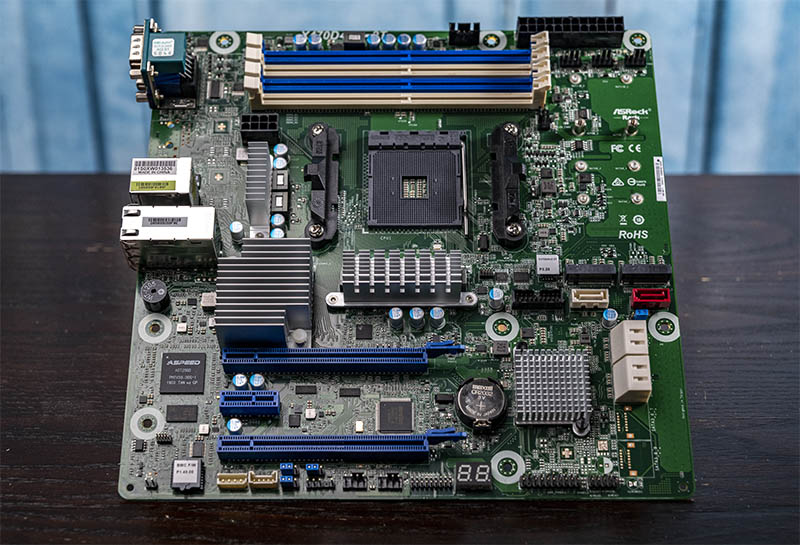
While many may prefer the X470D4U2-2T with dual 10Gbase-T, I personally would build around the X470D4U here instead. We have so many inexpensive 25GbE NICs, and I prefer SFP+/ SFP28 using SFP+ to 10Gbase-T adapters when necessary. It is actually less expensive to get a 25GbE card in the X470D4U than it is to get dual onboard 10Gbase-T in the X470D4U2-2T. This was a top-2 finalist but we decided against it.
AMD EPYC 3000 Series Powered
The AMD EPYC 3000 series in a mATX, specifically an AMD EPYC 3351 12-core platform with remote management and the I/O features exposed, would have been just about perfect. Here is the Wallaby development board, which is very close to what I would want.
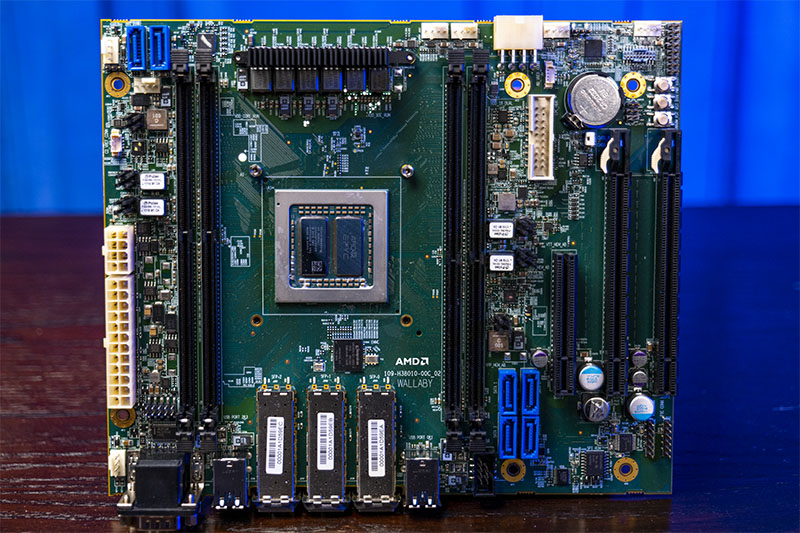
At the time we are doing this piece, the currently shipping platforms are mostly industrial-focused or mITX. Most are single-die solutions and do not offer 10GbE onboard.
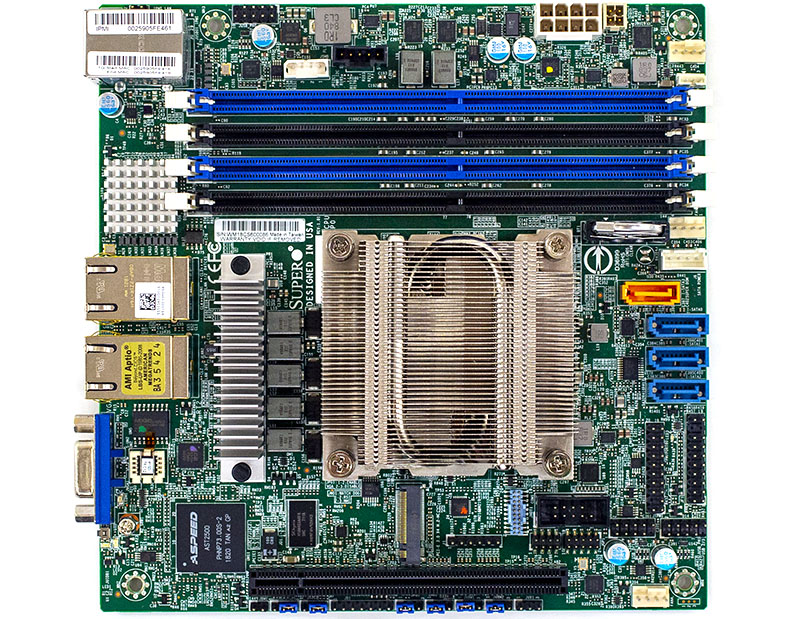
For a 4-bay solution this may be absolutely perfect, but for what we are aiming for we wanted a mATX platform.
AMD EPYC 7000 Series
The AMD EPYC 7000 series could have been very interesting, but it presented almost exactly the opposite set of problems that we had on the Xeon Scalable line.
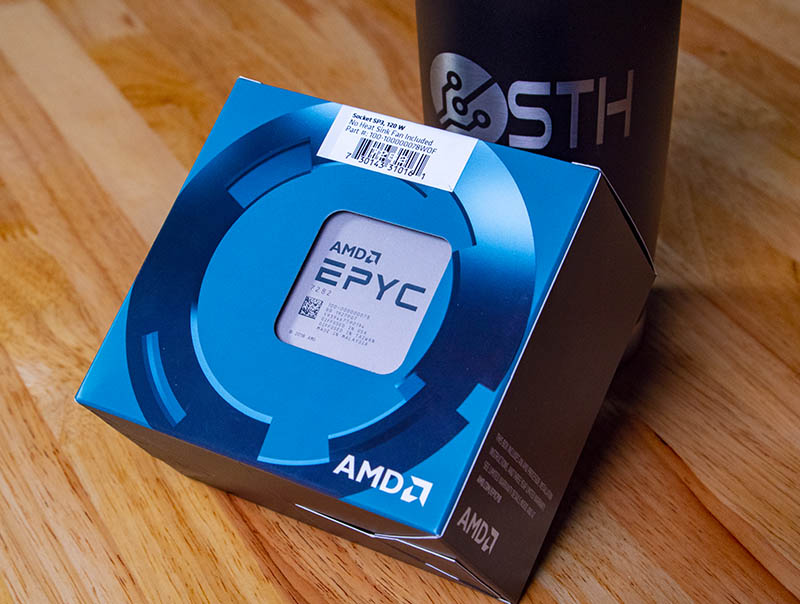
On one hand, cooling the CPU is very easy even though it is a higher-TDP platform. There are plenty of Threadripper closed-loop liquid cooling solutions that would have cooled the CPU in our SilverStone CS381 without issue. Since the physical mounting points of the Threadripper and EPYC 7000 series platforms are the same, this was easy and we had the liquid cooler on-hand.
The harder part was the motherboard. mATX is simply too small of a form factor for the EPYC 7000 series. With eight memory channels and a large socket, it takes up a lot of PCB space. Further, one of the most significant benefits would be getting a lot of PCIe I/O, but that would be mitigated on mATX due to form factor’s physical size. Great platform, but one needs a larger motherboard for it to really make sense. We did, however, Introduce the Ultra EPYC AMD Powered Sun Ultra 24 Workstation, which was a great use of that platform even in a smaller chassis.
What we used: Xeon D?
It feels a bit strange saying this in 2020, but we ended up using a Xeon D platform for this build. Using a 45W TDP SoC with 10GbE was extremely attractive. We ended up with the ASRock Rack D1541D4U-2O8R as our platform of choice.
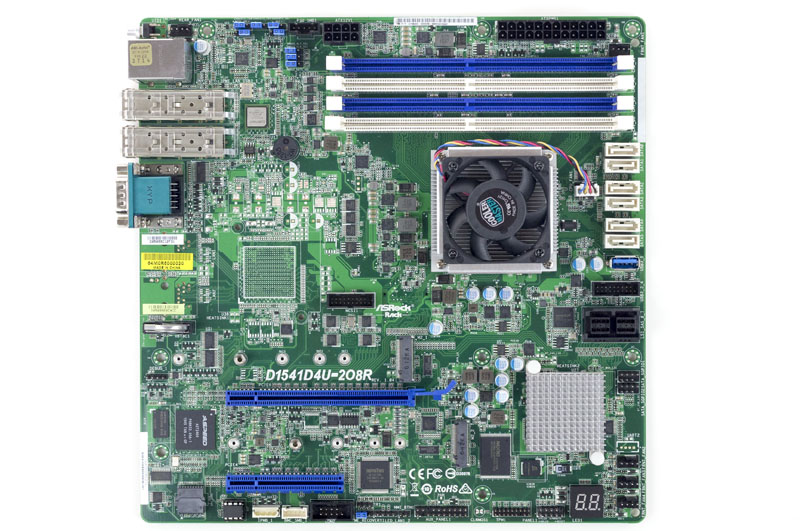
Frankly, this is still too much CPU for a FreeNAS or TrueNAS core build, so we probably would be better off with a Proxmox VE solution here. With ZFS and Linux becoming cozier, that would have made sense. The other nice thing is that the onboard SAS3 (Broadcom/ LSI SAS3008) uses a SFF-8643 connector, as does the backplane on the CS381. It just so happened, we had those cables on hand.
Here, not only is the TDP of the CPU lower than the Xeon E-2200 and Ryzen solutions, but it is also lower when one looks at the 10GbE networking TDP and chipset TDP. Also, the SAS3008 controller is effectively a universally supported solution these days, whereas some OSes are not as well suited to run on chipsets. The lower power consumption aligning with the decision that we wanted a lower-core count and memory solution meant that we went back to Xeon D.
Taking a moment here, that is borderline absurd. Five years after the Xeon D-1540 release, we are still going through a process and the Xeon D-1541, the updated part with the SR-IOV fix is what we are using. Then again, it shows the power of embedded parts and why we need products like the EPYC 3000 series for disruption.
Next we are going to look at some of the other build bits in this system before getting TrueNAS Core installed.




They should sell a FreeNAS MiniXXL with this setup for those that need more than Atom but still want a smaller FF.
Stop trying to make me subscribe to watch your content is stupid and doesn’t work on mobile
We do not have subscribe to watch filters. Everything is on YouTube or the STH main site without a registration wall.
Any performance issues with semi-disregarding the generally accepted wisdom/paradigms of the TrueNAS/FreeNAS gurus of recommending 1 GB of RAM per TB of storage? (Any benefits at all of running 128 GB over 64 GB?)
@Mark Dotson,
that 1GB RAM per 1TB storage is only partially true. Look at the offical hardware requirements/recommendations for FreeNAS: https://www.freenas.org/hardware-requirements/
In short (and not considering any RAM requirments of any other services running on your FreeNAS box), 8GB RAM is minimum and sufficient for 8 drives. Then, for any additional drive, an additional minimum of 1GB per drive is recommended. Note that those requirements/recommendations are not based on a RAM-per-storage-capacity metric, but rather based on RAM-per-drive.
Note that additional RAM can and will be utilized by the ZFS ARC for increased performance. Like with any other cache, how much of a performance gain a particular cache size will bring depends significantly on the usage scenario(s) that define the cache access patterns and the tiered cache hierarchy configuration (ARC and L2ARC).
What a coincidence!
I’m just waiting for delivery of the last four disks. Should arrive in the next hour or two.
My build:
CS381
450W Seasonic FOCUS SGX, Full Modular, 80PLUS Gold
X11SSH-CTF
E3-1260L V5 (also 45W, less cores than the D-1451, but higher per core clock)
64GB ECC
8 * DC520 (mix of SE/ISE,SAS/SATA so they’re from different mfg batches)
PMC NV1604 Flashtec NVRAM (if I can ever get it to work – it’s been EOLed so no control s/w) :(
Another option for the motherboard would be the Intel D-21xx based boards. Higher TDP but it has better performance per core. You make up for that with future expansion options or more flexibility now however when considering the boards it’s used on like X11SDV-8C-TP8F from SuperMicro. Lower price and you get 2xSFP+, 2x10Gbase-T, 4x1Gbase-T, Satadom, M2-nvme, pcie-x8 and x16 slots, and its VMWare certified. Perfect for a freenas, soho/lab fw/router, and room for a home automation guest or other light weight options.
Im running the X11SDV-8C-TP8F in the CS81 chassis, adapting a CU cooler to fit was the most difficult part of the build as the CPU sit partly under the drive trays.
How do you like it so far? I just finished building mine. Using a Plink web2208 rackmount case. Still waiting on new drives but I threw my old ones in it and booted it about 30 minutes ago. Havent had time to get esxi on it yet. Project for tomorrow.
Dr. Madness said: “8GB RAM is minimum and sufficient for 8 drives.”
What is your source for this info regarding very RAM amounts?
Perhaps someone should advise should advise their TrueNAS/FreeNAS/ZFS experts they’ve had it wrong for years…
They (the TrueNAS folks) seemed pretty clear in their recommendations for RAM amounts being related to 8 GB min, then add 1 GB of RAM per TB of storage capacity in Terrabytes, and not simply the ‘number of drives’, or, ‘add one GB for each drive above 8’ (which no one has EVER uttered/implied in the TrueNAS forums in the 4 years I’ve been reading them)…; and I’m reasonably certain there would logically be more RAM overhead involved in managing /correcting issues with 8 each 16 TB drives vs. 8 x 80-100 GB drives from 12 years ago, for instance…
EDIT: I do see Dr. Madness’ recommendations now listed officially as the minimal RAM recommendations on the TrueNAS page….; seeking clarification as to why /when the recommended was so drastically lowered… (Certainly makes TrueNAS a more affordable solution, hardware wise, if only 8 GB or 16 GB is sufficient now instead of 128 GB)
Do you need a storage controller that support JBOD for ZFS? Or create 8 RAID-1 arrays on the LSI controller?
1GB of ram / TB is only if you plan on using dedupe. I’ve got 128GB of ram in a box with 96TB Usable (144TB RAW), however that is overkill (I got a GREAT deal on the RAM). When I was running 64GB it was more than enough as well, my machine never struggles. IF you run DEDUPE, then yes it’s recommended, otherwise 32-96GB (depending on what you want to do with the box)
It’s more cost-effective to buy a complete server these days. I had actually considered building my own but ended up buying an HPE server and building around it.
An HPE ML110 Gen 10 with an 8 core Xeon Silver 4208 and 16gb of RAM is only $850:
https://www.provantage.com/hpe-p10812-001~7HEWY349.htm
STH review: https://www.servethehome.com/hpe-proliant-ml110-gen10-review/
Another 4 bay LFF drive cage is $105 (comes with cabling):
https://www.provantage.com/hpe-869491-b21~7HPE931F.htm
Another 16GB RDIMM is $175 (I know you can get memory much cheaper, but for this exercise I’m using real deal HPE labeled memory):
https://www.provantage.com/hpe-815098-b21~7HPE92F8.htm
You can get 8 real HPE drive sleds on eBay for around $60.
https://www.ebay.com/itm/LOT-OF-4-651314-001-HPE-TRAY-FOR-3-5-SAS-SATA-DRIVE-TRAY-DL160-DL380p-G8-G9/133331123957 (I have actually bought from this vendor before)
Likewise, you can get iLO Advanced on eBay for $30:
https://www.ebay.com/itm/HPE-iLO-Advanced-License-LIFETIME-GUIDE-2-3-4-5-ALL-Servers-FAST/253721355479
If you don’t want to use the built-in SATA ports, I bought a Broadcom/LSI 9400-16i HBA for $275 on eBay, though of course older cards are even cheaper.
Apples to apples, that’s $1,220, or just a tad under $1,500 with an HBA, for a much better system with a warranty and support. Even if you paid full retail for iLO Advanced instead of getting it on eBay you still come out way ahead.
I also just built a FreeNAS box with a D1541D4U-2O8R. For me it was the excellent price and feature set of that board that was a no brainier.
I originally planned on going with a C3758 based board, but there was none with SFP+ ports other than the A2SDI-H-TP4F for more than 2x the price.
I ended up getting a tiny 128 GB m.2 2230 for $30 as a boot drive.
I went with 4x16GB DDR4-2400 RDIMMs. It seems to be true on this board that if you only populate 2 RDIMMs the ram only comes up as DDR4 2133. (Still waiting on the extra 2 sticks to verify)
The only thing that i haven’t decided is if I need a L2ARC, and do i go another m.2 nvme (only PCIe2 1x) or SATA SSD?
I built this same setup for my first NAS. I purchased the MB from Newegg for 299.00 for a steal with only 32gb of ram. It runs my plex and unifi software with ease. Next step is more ram and surveillance software. Great article and now I can show some friends. They said it was overkill, but that’s what we do right?
I’m thinking of doing a build in this case myself, but I’m concerned about the HDD temps. Does anyone know how high they are during normal usage?
The Silverstone CS381 seems like a decent case. Better airflow than most, especially if you need the hot swap drives.
I prefer the Fractal Design Node 804. More and larger fans. It can still take full size PCI cards and full size ATX power supplies. It puts the board in a separate airflow pattern than the power supply and drives. A bit unique on form factor since it’s a big (almost) cube.
https://www.fractal-design.com/products/cases/node/node-804/
What a joke, NAS with $1300 motherboard but the HDD shucks…
Did you flash the LSI 3008 into IT mode for this setup?
Hello I’m planing my first FreeNAS build. I’m colorist and need a shared storage solution to work direclty out of.
I’ve been planing a build around the AsRock X570D4U-2L2T, however after reading this article I found a really cheap D1541D4U-2T8R on ebay and was wondering if it would be a better option to get that instead, however it’s a really old design and I don’t know if it makes sense to buy that in 2021…
What would you recommend?
Did you ever measure the fan noise? How did that turn out?